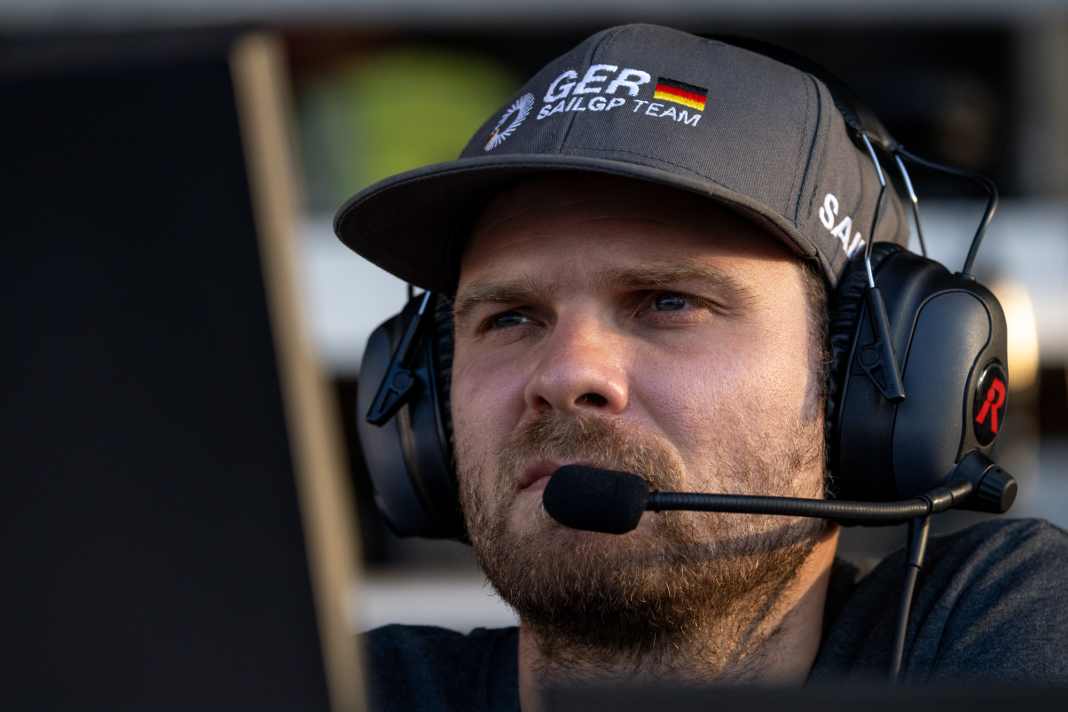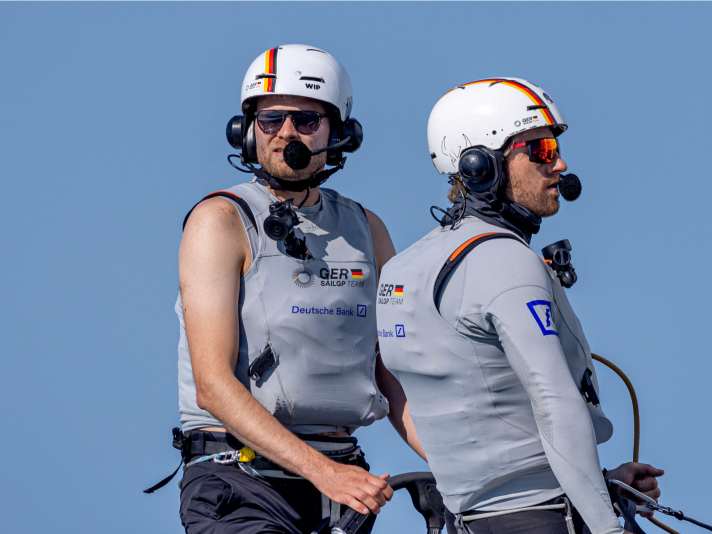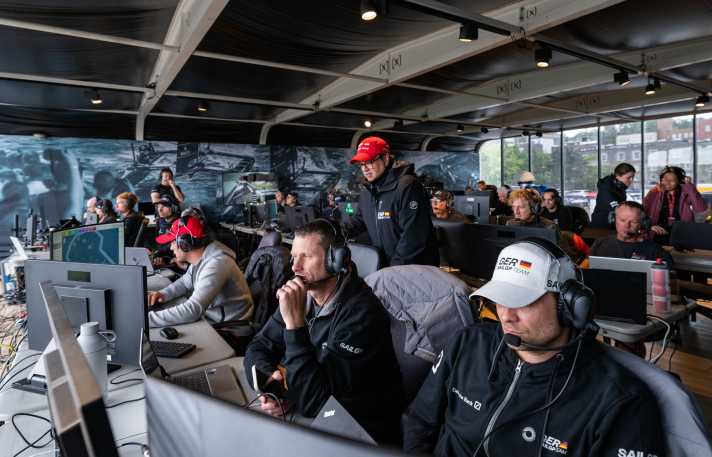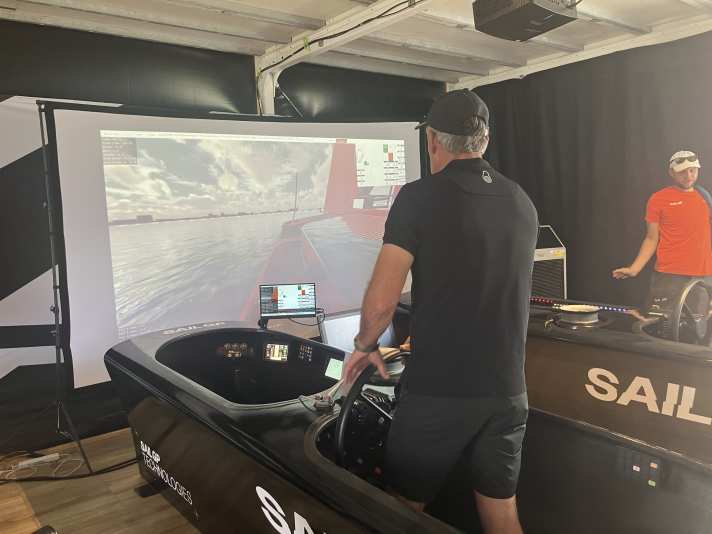SailGP: "A bit like David against Goliath" - Interview with coach Lennart Briesenick
Max Gasser
· 22.06.2024






YACHT: What are your first impressions from training in New York on Thursday and the practice races yesterday?
Lennart Briesenick: The day before yesterday was a great day. We had a full day of sailing, so we sailed for four and a half hours and really made the most of every minute. It was good to get to know the area here. Because there is also a bit of current here, which is relevant. At least when the boats are not foiling. A current model is built into the software of the boats so that the mooring lines are correct, for example. And that also seems to have worked quite well.
And today was a really difficult day, well below what we are capable of. It was probably one of our worst days so far and we all agree that it's below our level.
What were the problems?
Yesterday we had what we call 'marginal conditions', but in the upper range. So sometimes you're on the foils and sometimes not. You had to be very delicate to keep the boat afloat. And we made a few mistakes that could have been avoided, but which simply haven't been automated yet. And mistakes in such conditions are simply penalised extremely severely.
We were therefore definitely not competitive in terms of speed yesterday. We haven't seen the data yet, but we already have a pretty good feeling of what the data will show. And there were also difficulties in some of the manoeuvres. There were also some strategic issues where we took the laylines too early. It costs a lot to then go around the tonnes at slow speeds.
We were generally satisfied with the launches. We have been working on this right from the start and have also identified this as an important area of the entire project. We can learn quickly and also learn relatively quickly compared to the field and perform well there too. We have been measuring since the beginning of the year and since then we have been really good on the parameters. And everything was actually fine today.
There was a tricky situation with the Australians that ended with a point deduction for you. What happened?
The situation was after the leeward buoy. After the zone there is leeward before windward. It was also at the boundary. So all the rights were with Australia. We should have kept clear and didn't do that sufficiently. And then there was a contact. As far as I know, we will therefore be deducted four points in this event. So we start with four minus points. And then we will also be deducted two points in the season standings. If we finish fifth here, we would actually get five points, but this way we only get three points.
At this point, you will find external content that complements the article. You can display and hide it with a click.
Were there any other low points during the campaign that might even have made you doubt the whole project?
No, I wouldn't say that. I've often said to the team, even when things are going well and then a little worse, that it's a bit like David against Goliath. We are sailing here against people who have sailed on these boats, some of them in the last America's Cup editions, and of course generally against some of the best sailors in the world when it comes to fast boats. We're not sailing against a bunch of cucumbers here and the other teams also have more experience and even more training. It would be utopian to think that we could suddenly sail at the front from the outset. We always knew that it would be hard work to go through this learning process. The only thing we are currently measuring is how quickly we learn. And that's the only thing that matters to us. Given our learning curve and where we are on the various aspects, we've always been really happy so far.
So you're satisfied with the debut season?
The last two events are also important for me. So far, I can summarise and say that we are on target. We have set ourselves targets that are not result targets, but content targets, but quantified. There's something about starts, there's something about unforced errors, i.e. unprovoked errors and so on. These are a series of parameters that we measure. At the moment, we are in the green zone for all of them. Now we have to see how the last two events go and whether we slip into the red somewhere. But at the moment we are quite satisfied.
Is there a particular highlight that sticks in your mind?
Yes, one of the starts in Australia where the boys and girls dared to do something that the whole field didn't dare to do. And I think we went on to win the race. But the start was also really well organised.
How did you become the coach of the German SailGP team?
That was the classic phone call. Erik and I have known each other for a long time. I was almost the generation before him in the 49er, but narrowly missed out on qualifying for the London Olympics. I stopped sailing the 49er in my mid-20s and wanted to do something else in my life. Tobias Schadewaldt and Hannes Baumann then asked me to train for the Olympic Games. Before that, we were practically opponents in the elimination round. And the young training partners at the time were Erik and Thommy.

It was actually clear to me that I would do it with them, but then pursue my studies and take a different path in my life. Nevertheless, I kept supporting the national coaches and Erik and Thommy also kept asking me. I then worked in the event and conference business. Corona came along and of course we weren't doing well. Then I let myself be persuaded again for Tokyo (2021 Olympics, editor's note) because it was really difficult in my other job. But after that I was out, so to speak. Until Erik called again a year and a half later. And that's how it came about.
How was the transition from this type of coaching to your current job?
That was one of my biggest concerns. I also told Erik that I wasn't convinced that I was the right person for the job. And that there were people with more experience. It was about foiling and it was about catamarans and I had nothing to do with foiling and catamarans, at least at a high level. So we talked a bit longer and I had actually advised Erik that if he somehow had better options, he should go ahead with those because I'm always very interested in what's best for the project. But Erik had a few good points, because of course we had worked well together in the years before. And he also had little understanding of the project. The idea was for us to familiarise ourselves together, so to speak. With the help of the international guys he had on the boat. They would then coach us before I could take on more. But my learning curve also had to be very, very steep in order to understand the whole boat.
What are the responsibilities of a SailGP coach?
Of course, there's also a lot of organisation involved. I organise our daily schedules because these events are so staggered. With a large group of people, it's always important that everyone knows what they're supposed to do and when. That's an important aspect in order to have a foundation. During the event, however, I only take care of the sporting side of things. Together with my co-trainer Joe, of course, once we have the information about the weather, course and so on. Then we think about how to sail the course and so on. And between the events there is a lot of data analysis involved, even during the events, which is sometimes a bit difficult. Those are long evenings.
And then I also help with other issues in the project. I'm now employed full-time and we're still a bit under construction. I also have a bit of professional experience, which is not sailing coaching, but from the event and conference business. In this respect, I can also help a little in other areas.
This season, you coaches have been moved from your own boats on the water to a room on land with all the other coaches. What are the advantages and disadvantages of this?
I would say mainly advantages. As interesting as that sounds if you're used to being on the water. Mainly advantages, because the game, I always call it a game, is very different from the Olympic game. One of the parameters is that it's a data game and a digital game, so to speak. And that's incredibly difficult on the water with a screen and sun and not in a calm environment. Now, of course, you have several screens, it's very calm, you have communication with the team and you can also bring in the calm when it's very hectic on the water. That's a huge advantage. The only major disadvantage, I would say, is the view of the water surface, which no helicopter image can provide. So it's difficult for us to estimate the immediate distribution of the pressure and the turns.

A special feature is the communication with the team. Because you have all the data and are in permanent radio contact. How and how often do you use this during the race?
We approached it very carefully, because of course there is a lot of communication on the boat between the sailors. At the beginning, when you're learning to sail the boat, you're in the boat. And then at some point you have to start trying to get out of the boat in order to make tactical and strategic considerations and decisions. It's exactly the same here. We are still relatively much in the boat compared to many others. And in this respect, we have approached it very slowly, step by step, so to speak.
Are there certain situations in which you currently always intervene?
What we announce are the times to the boundary or mooring line. All those stories that are so mechanical that they are simply in the sailors' ears and they don't have to worry about them in the boat.
How do other teams utilise this option?
I'm not quite sure what it's like in other teams. We're in a room together, of course, but we all always wear headphones. What we always do is take the headphones off to listen to what others are saying. But basically we don't have a very specific idea of how others do it. Of course, we now have a former Canadian coach. And in that respect, I don't think there are any major differences in how it's handled.
Training days are extremely scarce in the SailGP. However, the league is currently pushing ahead with a simulator project. This could be a very attractive opportunity for new teams to gain experience as quickly as possible - for you too?
The simulator will be important for us and also for all the other new teams. It really was a piece of the puzzle that was missing in order to get up the learning curve faster.

How have you tried to close the experience gap as quickly as possible so far?
I think we met with the sailing team more than other teams in virtual briefings between events. Of course, we are travelling all over the world, so it was a challenge with the timing. We also started the project of installing the sailing software on Moths or Switch One Designs, so that we could sail SailGP in miniature. Simply to create all these tactical situations properly. As far as we know, no other team has done this before.
After New York, there's only San Francisco. How do you use the time between seasons?
We have the opportunity to train on the F50. The question at the moment is whether that will be in Bermuda or Dubai. In any case, we will be training for quite a few days to prepare for the next season. And as I said, we then have this switch project that we want to activate. We're basically waiting for the boats and for the software to be developed and customised. Those are the rough plans. And then, of course, we'll also look at whether larger foiling catamarans, such as the GC32, are a possibility for our training.
When the season starts again, German Olympic athletes may also be available. Have there already been any personnel plans for the new season?
Yes, we have that in mind, but it's important for us to finish the season and then take stock. And then we'll decide whether and how something can be changed for the season up to next year.
The SailGP races will be held on 22 and 23 June from 22.30 hrs. here at wedotv broadcast live.

